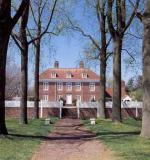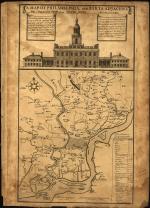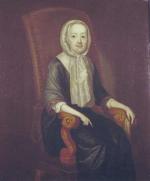Chapter Two: Penn's Arrival
On August 30, 1682, William Penn set sail from Deal, England to his New World colony on a ship called the Welcome. With him were about one hundred prospective colonists, one-third of whom would die after smallpox broke out during the voyage. Penn escaped the dreaded disease, having survived a bout with smallpox as a child.
The Welcome, the first of a fleet of twenty-three ships that carried more than 2,000 men, women and children to Pennsylvania in the next year, landed at New Castle (in present-day Delaware) on October 27, 1682. There, Penn presented his deed to the Dutch and Swedish inhabitants, who ceremoniously acknowledged him as their new proprietor and promised their allegiance. The following day Penn re-boarded the Welcome, and sailed up the Delaware River to the Swedish village of Upland, (present-day Chester). It was here, the site of Penn's Landing, that he first set foot in his colony of Pennsylvania.
Penn's Landing, that he first set foot in his colony of Pennsylvania.
That evening, Penn lodged at Essex House, the home of early Quaker settler Robert Wade. While there, Penn met with his cousin and deputy governor, William Markham, to discuss the on-going boundary dispute with Maryland, and Penn's intention to establish his capital at Upland. After learning that all of Upland's habitable waterfront property was occupied by Dutch, Swedes or Englishmen who were demanding high prices for their real estate, Penn agreed to find an alternative location for his capital.
Essex House, the home of early Quaker settler Robert Wade. While there, Penn met with his cousin and deputy governor, William Markham, to discuss the on-going boundary dispute with Maryland, and Penn's intention to establish his capital at Upland. After learning that all of Upland's habitable waterfront property was occupied by Dutch, Swedes or Englishmen who were demanding high prices for their real estate, Penn agreed to find an alternative location for his capital.
"If you cannot find enough land by the water side to allow an hundred acres to five thousand acres," he instructed his agents, "get what you can, and proportionately divide it, though it were but fifty acres a share." Responding to the directive, Penn's agents recommended that the capitol be established on a sparsely settled peninsula at the confluence of the Schuylkill and Delaware rivers. Named Philadelphia, or "City of Brotherly Love," the peninsula was also one of Penn's original three counties, along with Bucks and
Bucks and  Chester.
Chester.
Shortly after his arrival, Penn may have met with a group of Delaware Indians a few miles north of Philadelphia at Shackamaxon, although no record exists of such a meeting. What is known is that he summoned the freeholders of the three original counties to a meeting at Chester on December 4, 1682. There, those in attendance approved his draft for a constitution, known as the Great Law, which granted all Pennsylvanians citizenship. The constitution also set the minimum voting age at twenty-one years, determined that taxes would be assessed on an annual basis and united the three lower counties of New Castle, Kent and Sussex (present-day Delaware) with Pennsylvania.
The capital city of Philadelphia laid claim to most of Penn's attention during his first months in the colony. He appointed Thomas Holme as Surveyor General of Pennsylvania, and immediately directed him to lay out "a greene country town where every house be placed in the middle of the plot, so that there may be ground on each side, for gardens, or orchards or fields and so that it will never be burnt, and always be wholesome." Penn also called for the creation of parks. He directed that "four squares be set aside for physical recreation" and that a "ten-acre Center square be reserved for a House of Public Affairs." He also mandated that land for "Publick Houses" be set aside on every block as community gathering places. Streets running east-west were to be named after trees, and those running north-south were to be numbered. This grid pattern would set a precedent for many future American towns.
Thomas Holme as Surveyor General of Pennsylvania, and immediately directed him to lay out "a greene country town where every house be placed in the middle of the plot, so that there may be ground on each side, for gardens, or orchards or fields and so that it will never be burnt, and always be wholesome." Penn also called for the creation of parks. He directed that "four squares be set aside for physical recreation" and that a "ten-acre Center square be reserved for a House of Public Affairs." He also mandated that land for "Publick Houses" be set aside on every block as community gathering places. Streets running east-west were to be named after trees, and those running north-south were to be numbered. This grid pattern would set a precedent for many future American towns.
Penn lived in a slate roof house on Front Street, today the site of Welcome Park. From there he supervised the distribution of land, organized the government (which first met on March 12, 1683) and negotiated with the Lenape, when not shuttling back and forth from New Castle, Chester, New York, New Jersey and Maryland.
During his second visit in 1699-1701, Penn lived at a country estate he had built 26 miles north of Philadelphia on the Delaware River. Known as Pennsbury Manor, this 8,400-acre Bucks County retreat satisfied the Quaker proprietor's desire for a country life. A courtly Georgian-style, manor house, large enough for his family and half dozen servants, was the centerpiece of the estate, around which were located gardens, a vineyard, an orchard and several outbuildings, including a Bake and Brew House, icehouse, joiner's house and plantation office.
Pennsbury Manor, this 8,400-acre Bucks County retreat satisfied the Quaker proprietor's desire for a country life. A courtly Georgian-style, manor house, large enough for his family and half dozen servants, was the centerpiece of the estate, around which were located gardens, a vineyard, an orchard and several outbuildings, including a Bake and Brew House, icehouse, joiner's house and plantation office.
Forced to return to England in 1700 to protect his control of the colony from the government and to remain there because of poor health, Penn spent only four years in his "Holy Experiment;" from 1682 to 1684 and again from 1699 to 1701. Between those two visits, Penn became a widower. His wife Gulielma Maria Springett died. Before he returned to his colony in 1699, Penn married young Hannah Callowhill, who soon after arriving in Philadelphia gave birth to a son, John.
Hannah Callowhill, who soon after arriving in Philadelphia gave birth to a son, John.
After Penn suffered a stroke in 1712, Hannah served as Pennsylvania's acting proprietor and head of government until her death in 1726. Working with a series of deputy governors, Hannah, who was very astute in matters of business, preserved Penn's noble vision. She maintained peaceable relations with the Lenape, Conestoga and Iroquois, prevented the outbreak of civil war between Pennsylvania and Maryland over the on-going boundary dispute and lessened the political dissension that existed in Pennsylvania's assembly. At the same time, she thwarted attempts by her stepchildren and son-in-law to lay claim to the province, and prevented Penn's eldest son, highly irresponsible William Penn, Jr., from taking his place as head of the family.
The Welcome, the first of a fleet of twenty-three ships that carried more than 2,000 men, women and children to Pennsylvania in the next year, landed at New Castle (in present-day Delaware) on October 27, 1682. There, Penn presented his deed to the Dutch and Swedish inhabitants, who ceremoniously acknowledged him as their new proprietor and promised their allegiance. The following day Penn re-boarded the Welcome, and sailed up the Delaware River to the Swedish village of Upland, (present-day Chester). It was here, the site of
That evening, Penn lodged at
"If you cannot find enough land by the water side to allow an hundred acres to five thousand acres," he instructed his agents, "get what you can, and proportionately divide it, though it were but fifty acres a share." Responding to the directive, Penn's agents recommended that the capitol be established on a sparsely settled peninsula at the confluence of the Schuylkill and Delaware rivers. Named Philadelphia, or "City of Brotherly Love," the peninsula was also one of Penn's original three counties, along with
Shortly after his arrival, Penn may have met with a group of Delaware Indians a few miles north of Philadelphia at Shackamaxon, although no record exists of such a meeting. What is known is that he summoned the freeholders of the three original counties to a meeting at Chester on December 4, 1682. There, those in attendance approved his draft for a constitution, known as the Great Law, which granted all Pennsylvanians citizenship. The constitution also set the minimum voting age at twenty-one years, determined that taxes would be assessed on an annual basis and united the three lower counties of New Castle, Kent and Sussex (present-day Delaware) with Pennsylvania.
The capital city of Philadelphia laid claim to most of Penn's attention during his first months in the colony. He appointed
Penn lived in a slate roof house on Front Street, today the site of Welcome Park. From there he supervised the distribution of land, organized the government (which first met on March 12, 1683) and negotiated with the Lenape, when not shuttling back and forth from New Castle, Chester, New York, New Jersey and Maryland.
During his second visit in 1699-1701, Penn lived at a country estate he had built 26 miles north of Philadelphia on the Delaware River. Known as
Forced to return to England in 1700 to protect his control of the colony from the government and to remain there because of poor health, Penn spent only four years in his "Holy Experiment;" from 1682 to 1684 and again from 1699 to 1701. Between those two visits, Penn became a widower. His wife Gulielma Maria Springett died. Before he returned to his colony in 1699, Penn married young
After Penn suffered a stroke in 1712, Hannah served as Pennsylvania's acting proprietor and head of government until her death in 1726. Working with a series of deputy governors, Hannah, who was very astute in matters of business, preserved Penn's noble vision. She maintained peaceable relations with the Lenape, Conestoga and Iroquois, prevented the outbreak of civil war between Pennsylvania and Maryland over the on-going boundary dispute and lessened the political dissension that existed in Pennsylvania's assembly. At the same time, she thwarted attempts by her stepchildren and son-in-law to lay claim to the province, and prevented Penn's eldest son, highly irresponsible William Penn, Jr., from taking his place as head of the family.












